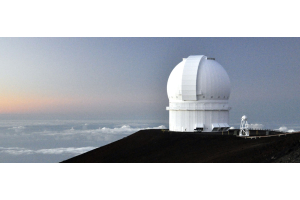
In this video Teagan shares an overview of some of the beautiful celestial objects we can see in the night sky for the month of May 2022.

Image source: Kazuhiro NOGI
Total Lunar Eclipse - May 15th & 16th
There are two total lunar eclipses visible from North America in 2022, and while May’s favors the east coast, November’s will favor the west. Totality lasts 1 hour and 25 minutes for both, giving observers throughout the continent the opportunity to see the Moon fully eclipsed.
The penumbral phase of May’s eclipse begins at 9:32 PM ET, but you may not notice a difference until the partial phase begins nearly an hour later. Totality begins at 11:29 PM ET (8:29 PM PT), when the Moon is high over the south for east coast observers but low over the eastern horizon for those in the west. The Moon will be among the faint stars of Libra at the time, but look to the east and compare its color to ruddy Antares in Scorpius.
Totality ends at 12:53 AM ET (9:53 PM PT) with the partial phase ending an hour and two minutes later. Finally, the end of the penumbral phase also signals the end of the eclipse itself at 2:50 AM ET (11:50 PM PT).
OUR NEAREST NEIGHBORS
Uranus is in conjunction with the Sun on the 5th and therefore won’t be visible this month, leaving Mercury as the only planet to be seen in the evening sky. It’s visible toward the west-northwest after sunset, with the crescent Moon appearing to its upper left on the 2nd. Be sure to catch Mercury while you can, as it will be gone by mid-month.
Meanwhile, in the morning sky, Saturn continues to trundle through the northeastern corner of Capricornus and is joined by the last quarter Moon on the 22nd.
Mars and Neptune appear within the same binocular field of view from the 10th to the 27th, with the pair just 33 arcseconds apart on the 18th.
Mars then hops into Pisces the next day and into the same binocular field of view as Jupiter. It’ll catch up to the giant planet on the 29th when 35 arcseconds will separate them. This is Jupiter’s second conjunction of the month, as it’ll be 37 arcseconds away from Venus on the 1st. The waning crescent Moon appears nearby on the 26th and 27th.
There’s a total lunar eclipse when the Moon turns full on the 15th. It then turns new on the 30th.

Image credit: NASA
The Eta Aquariid Meteor Shower
While best seen from the southern hemisphere, the Eta Aquariid meteor shower can produce 10-30 shooting stars in the early hours of May 5th. This year could be worth the effort as the waxing crescent Moon will set early in the evening before.

Image credit: Gary Fildes
Mizar & Alcor
One of the most famous double stars in the sky, Mizar & Alcor make an easy target for naked-eye observers. Binoculars provide a nice view of the pair, but Mizar is itself double, and a small telescope at low power is all you need to split it.

Image credit: Wikisky
Alpha Canum Venaticorum - Cor Caroli
Like Mizar, Cor Caroli can be split with any telescope at low power. The primary appears white and about 2 or 3 times brighter than the pale gold secondary star.

Image credit: NASA
M101 - The Pinwheel Galaxy
A 200mm scope can show the Pinwheel’s bright core and faint arms, but you’ll need a light pollution filter to bring out any further details.
STELLAR CONCEPTS
Optical Double: You can potentially see thousands of stars on any clear, dark night, but take a closer look with binoculars or a telescope and some of those could be split into two or three components. While many of these are true multiple star systems, there are also some that aren’t gravitationally bound to one another. These stars merely appear close together due to a chance alignment of the stars in the sky and are therefore called optical doubles. Mizar and Alcor, once thought to be an optical double pair, are now thought to be a true multiple star system, with the two stars orbiting one another once every million years.
This Article was Last Updated on 07/25/2023











